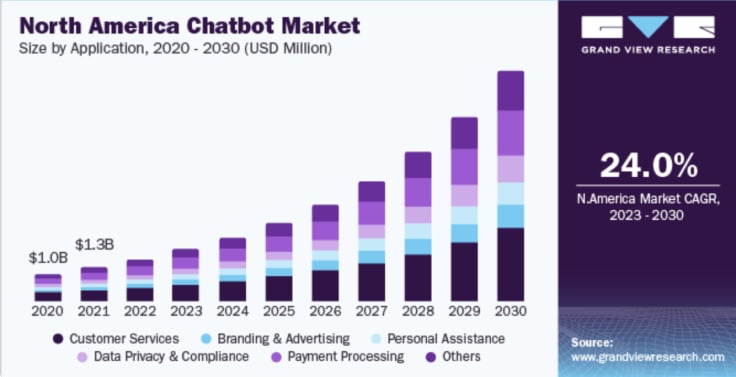Showing top 0 results 0 results found
Showing top 0 results 0 results found

Updated 11.01.2024
The first chatbot (Eliza) dates back to 1966, making it older than the Internet. However, the technology had to wait some time to thrive on a large scale. It was not until 2016 that Facebook allowed developers to place chatbots on Messenger. Brands started to develop their chatbot technology, and customers eagerly tested them to see their capabilities.
Although the interest in chatbots started to subside in 2019, the chatbot industry flourished during the pandemic. Chatbots ended up making huge gains in 2023 with the massive AI boom due to the increasing popularity of ChatGPT.

Many companies have decided to use AI in their teams to stay afloat. This included chatbots. For example, chatbots could automate as much as 73% of admin tasks in healthcare, according to Zendesk.
Companies have been eager to implement chatbots to deal with regular customer service interactions, improve customer experience, and reduce support costs.
I gathered a few chatbot stats to show how chatbot usage has evolved over the past few years. Let's jump in!
1. Customer preferences
Research shows that customers have already developed a preference for chatbots. Consumers turn to them for various issues or when in a hurry.
They are okay with being served by a chatbot as long as it answers their questions in real time and helps them solve their problem quickly.
One downside is the waiting time for human agents when chatbots need help. In these cases, customers expect to be quickly placed on a live chat with a human agent who can solve their problems as soon as the bot. However, chatbots are still good enough for many customers:
- 35% of people use chatbots to resolve complaints or obtain detailed information. (Backlinko)
- 74% of internet users prefer interacting with chatbots when seeking answers to straightforward questions. (PSFK)
- 41.3% of buyers turned to digital assistants after 2020 for purchases. (Drift)
- 33% of customers preferred using a chatbot to make a reservation at a restaurant or hotel. (Drift)
- 40% of web users are indifferent to being served by bots or human agents as long as they receive the necessary customer support services. (HubSpot)
- 64% of consumers find 24/7 availability to be the most helpful feature of a chatbot. (The Chatbot)
- 48% of people prioritize a chatbot's ability to resolve issues over the chatbot's personality. (Business Insider)
2. Chatbot usage
Younger generations are interested in chatbot technology. Millennials like to deal with support issues independently, while Gen-Z is happiest coping with issues with short messages that lead to a goal (LiveChat Gen-Z Report).

Chatbots are the ideal solution in both cases.
- 60% of millennials rely on using chatbots. (Service Bell).
- The statistical user sends four inquiries to the bot during one chat session. (ChatBot)
- 20% of Gen Z users prefer starting their customer service experience with a chatbot and switching to a live human if necessary. (Northone)
- There are currently more than 300,000 chatbots in operation on Facebook Messenger alone. (Blogging Wizard)
- 90% of businesses report significant improvements in the speed of complaint resolution. (MIT Technology Review)
- Giants such as LinkedIn, Starbucks, British Airways, and eBay will continue using chatbots in 2024.
- 58% of websites that use chatbot software are for B2B companies. (Boomtown)
- 80% of customers who have used chatbots report the experience as positive. (Uberall)
3. AI chatbot market statistics
The growing popularity of artificial intelligence in many industries, such as banking chatbots, health, or ecommerce, makes AI chatbots even more desirable. Reduced working hours, a more efficient team, and savings encourage businesses to invest in AI bots.
Would you like to grow your business with AI?
- The global chatbot market is expected to expand at a compound annual growth rate (CAGR) of 23.3% from 2023 to 2030. (Grand View Research)
- 23% of travel and hospitality companies worldwide use chatbots to enable users to make general inquiries or complete bookings. (Digital Dialog)
- 50% of customers like to talk with AI chatbots. (Dashly)
- 84% of businesses believe AI chatbots will be increasingly important in customer communication. (CCW).
- 79% of employees believe that AI technology positively impacts business performance. (Capterra)
- AI-powered proactive chat can increase conversion rates by 15%. (Zowie)
- The worldwide chatbot market has been divided into Marketing, AI, and Human Intelligence. Marketing is predicted to get the most significant market share, growing at a CAGR of 23.7% by 2030. (GlobeNewswire)
- Artificial intelligence automated up to 73% of healthcare admin tasks in 2023. (Business Insider)
- By 2025, the global chatbot market will reach over $1.2 billion. (Grand View Research)

- In 2024, retail consumers will spend over $142 billion via chatbots — up from $2.8 billion in 2019. (Insider Intelligence)
4. Social media and messaging
Social media has transformed how people communicate, which has impacted the frequency, timing, and length of their interactions.
People constantly exchange messages with their friends and family members, and this communication trend has extended to how they interact with businesses.
As a result, brands are facing new challenges in terms of communication. However, chatbots have emerged as a solution to help businesses navigate this changing area, especially as new communication channels continue to emerge.
- 1.4 billion people use messaging applications and are eager to communicate with chatbots. (Localiq)
- Ecommerce stores that have implemented Facebook Messenger and an abandoned cart chatbot are experiencing a boost in revenue ranging from 7-25%. (Localiq)
- On average, a chatbot conversation lasts about five or six messages. (Localiq)
- 55% of consumers are willing to interact with a business via messaging apps to solve a problem. (HubSpot)
- In the first half of 2023, consumers spent over 2.5 trillion hours on Android phones, indicating increased mobile app usage. (Data.ai)
- Facebook, YouTube, and WhatsApp were the most popular social networks in 2023. (Statista)

- Over 100 billion messages are sent through Facebook Messenger every day by people. (Blogging Wizard)
- Conversations between brands and customers via Facebook Messenger have a 30% better ROI than retargeting ads. (Business Insider)
5. Benefits for business
Customer support bots
There are over 2 billion digital buyers worldwide. Given the current trends that intensified during the pandemic and after the excellent craze for AI, there will be only more customers who require support in the future.
Therefore, customer service bots are a reasonable solution for brands that wish to scale or improve customer service without increasing costs and the employee headcount.
- The majority of issues on live chat get resolved within 42 seconds. (Localiq)
- 64% of customer service agents who utilize AI chatbots can spend most of their time solving complex cases. (Salesforce)
- 134,565,694 chats were held by ChatBot in 2023. (LiveChat)
- Businesses that offer more engaging and high-quality chatbot experiences witness 70% more customer interactions and responses. (Localiq)
- 81% of customers prefer using self-service options before contacting a customer service representative. (HubSpot)
- Annually, companies lose a significant amount, ranging from $75 billion to $1.6 trillion, due to inadequate customer support. (Midlands Technical College)
- 67% of internet users have used social media, live chat, or texting to contact customer service. (eMarketer)
- 56% of customers prefer to message rather than call customer service. (Outgrow)
- Chatbots can take care of 30% of live chat communication. (LiveChat)
- In 2023, the average queue waiting time was 3 min 40 sec (compared to 5 min 16 sec in 2022). (LiveChat)
Chatbot industry for marketing
Recent advancements in chatbot technology and machine learning have enabled chatbots to provide a more personalized customer experience.
Apart from offering personalized support at scale, businesses increasingly use chatbots to promote their products and services, generate leads, and increase website engagement.
- 80% of companies use conversational marketing tools to engage with customers and potential clients. (Drift)
- 17% of businesses want to achieve their marketing and lead generation goals using chatbots. (Tidio)
Chatbot technology in sales
Customers use multiple channels to search for products. As a result, businesses that offer a more significant number of touchpoints increase the likelihood that customers will come across their products and choose them.
However, managing effective customer service across multiple selling channels is becoming increasingly challenging due to consumers' reduced patience. Customers expect brands to respond to their sales inquiries instantly; chatbots and virtual assistants can help achieve this goal.
- 41% of all business chatbots are used for sales purposes. (Intercom)
- 35% of business leaders declare that virtual agents made it easier to close sales deals. (Intercom)
- 36% of businesses incorporate chatbots into their lead-generation strategies to enhance efficiency and effectiveness. (Localiq)
6. Voice
When discussing chatbot statistics, it's essential to acknowledge the growth of voice technology. Although it may not be as commonly used in customer support and marketing operations as chatbots, it is still advancing in its own right.
Brands like Google and Amazon are leading the way in making voice technology more personalized and user-friendly.
- The number of voice search users is projected to reach 125.2 million by 2024, up from 123.5 million in 2022. (Yaguara)
- 46% of Americans use digital voice assistants. (Pew Research)
- 1 in 6 Americans owned a smart speaker in 2018. (NRP and Edison Research)
- The top popular keywords in voice search phrases are "how", “what", and "best". (Frontier Marketing)
- 20% of searches on the Google App are conducted using voice commands. (Think with Google)

- Approximately 45% of Americans utilize voice assistance on their smartphones for information discovery. (Semrush)
- Google Assistant is compatible with over 50,000 smart home devices. (SerpWatch)
- 71% of consumers are satisfied with the voice assistants on their mobile devices. (Forbes)
- 43% of voice device owners use it to shop. (Review42).
- Google Home is reported to answer 81% of the queries correctly. Amazon Alexa does worse, as it correctly answers 34% of queries. (CNET)
🚀 Looking for ways to add a burst of freshness to your marketing?
Start using ChatBot nowChoose the best chatbot tool for your business in 2024
Chatbots have become an integral part of our daily lives, and their usage will only increase with time. They help us shop, answer our queries, and conveniently provide customers with relevant information.
Investing in a good tool for your business will improve customer satisfaction and help it thrive in 2024.
ChatBot is an AI-powered tool that enables you to provide continuous customer support. It scans your website, help center, or other designated resource to deliver quick and precise AI-generated answers to customer queries. With ChatBot, you don't need any coding skills to get started. Help your business grow with the best chatbot app, and sign up for the free 14-day trial now.



